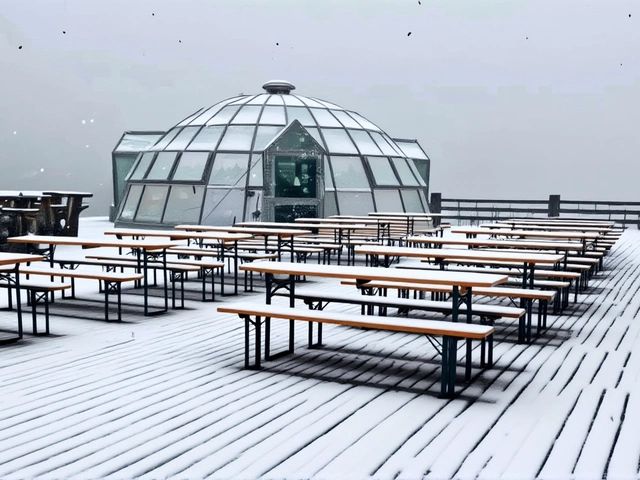When Chicago families gather for Thanksgiving dinner on Thanksgiving 2025Chicago, they won’t just be passing the turkey—they’ll be bundling up in scarves and mittens. A polar vortex disruption, triggered by a rare Sudden Stratospheric Warming (SSW) event, is set to plunge the city into a sharp cold snap just as millions prepare to travel. After a brief warm-up with highs in the mid-50s from Sunday, November 23 through Wednesday, November 26, temperatures will plummet. Thanksgiving Day itself will only reach 45°F, according to Time and Date, and by Friday, November 28, highs will hover near 41°F with lows dipping to 33°F. By Saturday, it’ll be a bone-chilling 36°F high and 30°F low. This isn’t just a cold snap—it’s a pattern shift that could define the entire winter.
Why This Cold Snap Is Unusual
Normally, polar vortex disruptions happen in December or January, not late November. But this year, National Weather Service meteorologists are watching an unusual atmospheric dance. A massive wave of energy—called a Rossby wave—pushed upward into the stratosphere, destabilizing the polar vortex and sending frigid air spiraling southward. Fox 32 Chicago explains that while the term "polar vortex" often conjures images of -30°F wind chills, this event won’t be that extreme. Still, with highs stuck in the 30s and lows in the 20s, it’s significantly colder than the Thanksgiving average of 43°F high and 29°F low.
Adding to the complexity is La Niña, which is already influencing global weather patterns, and the Madden-Julian Oscillation, a tropical pulse of rain and wind that’s helping steer this cold air into the heartland. Together, they’re creating a perfect storm for winter-like conditions across the Midwest. NOAA warns this could mean heavier lake-effect snow along the Great Lakes, especially near Chicago’s shoreline.
Travel Chaos Looms for Record Holiday Rush
It’s the busiest travel weekend of the year. AAA forecasts a record 81.8 million Americans will hit the road or skies. The Transportation Security Administration expects to screen 17.8 million air travelers between Tuesday, November 25, and Sunday, November 30—with over 3 million screened on the final day alone. But Chicago O’Hare, one of the nation’s busiest hubs, could face major disruptions. A cold front sweeping across the northern tier on Wednesday, November 26, may bring snow to Minnesota and rain to the Northeast, triggering delays at airports from Boston to Minneapolis. Airline crews are bracing for de-icing operations, runway closures, and canceled flights.
"We’ve seen this before," says a TSA spokesperson. "But never with this many people and such a rapid temperature drop." The agency is urging travelers to arrive two hours early and check flight status frequently. Ground crews are being doubled up, and emergency snow removal equipment is being pre-positioned at major terminals.
What Experts Are Saying
Dr. Judah Cohen, a senior atmospheric scientist at Aerospace Corporation and cited by ABC News, cautions that while an SSW isn’t guaranteed, even a stretched polar vortex could bring prolonged cold. "It’s not about one big plunge," he says. "It’s about lingering cold that makes the weekend feel like mid-December." The National Weather Service Climate Prediction Center gives Illinois a more than 30% chance of below-normal temperatures through Thanksgiving weekend—a rare statistical edge that underscores how unusual this pattern is.
"This isn’t just a Thanksgiving chill," adds a meteorologist at Secret Chicago. "It’s a preview. If this pattern holds, December could be the coldest in years. Break out the winter gear now—it’s not going away." The site even advises residents to "opt for indoor activities" and "layer up," noting that ice patches on sidewalks and frozen car doors will be common.

What Comes Next
The cold isn’t ending after the holiday. The National Weather Service predicts the pattern will persist into early December, with the potential for multiple Arctic outbreaks. "For December overall," they note, "as a change from many recent Decembers, we may very well see a colder, more active start to meteorological winter 2025-2026." That means more snow, more ice storms, and longer periods of sub-freezing temperatures.
Residents are being urged to check on elderly neighbors, ensure heating systems are working, and keep emergency kits stocked with blankets, flashlights, and non-perishable food. The city’s emergency management team has activated its winter readiness protocol, with public shelters on standby and snowplow routes mapped out.
Why This Matters Beyond Chicago
This isn’t just a local story. The National Weather Service issued a broad warning: below-average temperatures are likely across the Central and Northern U.S., from the Pacific Northwest to the Great Plains and even into Texas. Farmers in Iowa are bracing for frozen crops. Power companies in Ohio are preparing for surges in heating demand. Even grocery stores in Milwaukee are stocking up on soup and hot beverages ahead of schedule.
It’s a reminder that weather extremes are no longer anomalies—they’re part of a new normal. And when a polar vortex hits during Thanksgiving, it doesn’t just affect the forecast. It affects families, flights, food deliveries, and the simple joy of getting home for the holidays.
Frequently Asked Questions
How cold will it actually get in Chicago on Thanksgiving weekend?
Temperatures will drop sharply after a brief warm-up. Thanksgiving Day (Nov. 27) will peak at 45°F, but by Friday, Nov. 28, highs will fall to 41°F with lows near 33°F. Saturday, Nov. 29, will see highs of 36°F and lows of 30°F. Wind chill could make it feel 10–15 degrees colder, especially near Lake Michigan. This is well below the historical Thanksgiving average of 43°F high and 29°F low.
Is this polar vortex event unusual for November?
Yes. Polar vortex disruptions typically occur in December or January. This one is being triggered by a rare Sudden Stratospheric Warming event in late November, which is historically uncommon. The National Weather Service notes that while the cold won’t be extreme enough for -20°F readings, the timing makes it unusual and potentially disruptive during peak travel season.
How will this affect air travel at Chicago O’Hare?
Delays and cancellations are likely. The cold front moving through on Nov. 26 may bring snow to Minnesota and freezing rain to Chicago, triggering de-icing delays and runway closures. With over 3 million air travelers expected on Nov. 30 alone, the Transportation Security Administration is urging passengers to arrive two hours early and monitor flight status. Over 17 million air travelers are projected nationwide during the holiday period.
What’s the connection between La Niña and this cold snap?
La Niña shifts jet stream patterns, pushing colder air southward across the central U.S. Combined with the Madden-Julian Oscillation, which brings a pulse of atmospheric energy eastward, these two forces are amplifying the polar vortex’s southward push. This synergy increases the likelihood of prolonged cold and snow, particularly in the Great Lakes region, where lake-effect snow is already common.
Should I be worried about power outages or frozen pipes?
Yes. The prolonged cold increases strain on heating systems and raises the risk of frozen pipes, especially in older homes. Utility companies in Illinois have already begun preparing for higher demand. Residents are advised to keep thermostats at 68°F or higher, let faucets drip slightly overnight, and check insulation around pipes. Emergency shelters are on standby in case of widespread outages.
Is this the start of a harsh winter overall?
Meteorologists say it could be. The National Weather Service warns that December 2025 may mark a "colder, more active start to meteorological winter 2025-2026," contrasting with recent mild Decembers. If the polar vortex remains unstable, we could see multiple Arctic outbreaks through January. This early cold snap may be the first of several.






